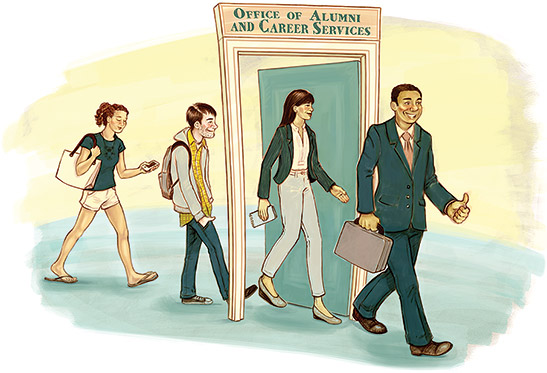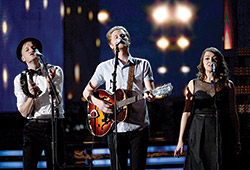

Professional Alchemy
Even the best apprentices need someone to show them the ropes. At a recent lunch, for example, marketing students sat down with Alex Stultz, ’94, director of merchandising for the Dave Matthews Band. Baritone Matt Worth, ’00, gave a few master classes during his campus stopover to perform at the Modlin Center. And at the law school, students hear each year about judicial clerkships from alumni who sit as judges.
Career services programs around campus cover everything from networking to etiquette and what to expect in an interview. There are panels and expos, lunches, roadtrips, and bootcamps.
Alumni play a key role in many of them, giving students the opportunity to get in front of people who might turn out to be potential employers.
And in any job market, it’s all about the relationships.
That’s the experience of Brandt Portugal, ’02, a biology major who broke into the financial industry on Wall Street with the help of alumni connections made through the Office of Alumni and Career Services.
Now he gives students similar connections through Deconstructing Wall Street, a program the University’s alumni association sponsors. Portugal, who serves on the URAA board, helped organize the first program with co-chair Jordan Rice, ’07. This year Lindsay Cressy, ’05, co-chaired the event with Rice—and Portugal remains committed to finding similar opportunities for students in other fields.
“We’re constantly thinking of ways to connect alums to undergraduate students,” Portugal said. “One of the best ways is either in a mentor or career advisory role.”
To learn more about getting involved with Richmond’s career services programs, visit hirespiders.richmond.edu or email hirespiders@richmond.edu.
The Definition of Brotherhood
Pi Kappa Alpha’s creed doesn’t get into details and examples.

"Ho Hey": The Lumineers—led by frontman Wesley Schultz, ’05 (center)—were nominated for Best New Artist and Best Americana Album at the 55th Grammy Awards. Just before the award show, Schultz and company took the stage on Saturday Night Live. The group didn’t walk away with any Grammy hardware, but that didn’t dim their outlook. “We’re pretty honored to be nominated, and that’s pretty shocking in and of itself,” Schultz told TV host Carson Daly before the Grammys. “To me, it means I don’t have to bus tables any time soon.”
But it doesn’t have to.
Take the example of Matt Felix and Pat Kacani, both ’85. The two New Jersey natives met freshman year playing soccer, pledged PIKA together, and later became roommates. After graduating, Kacani stayed in Virginia, and Felix went back to Jersey. The two stayed in close touch—sharing stories from work and their families, including Felix’s son, Andrew, a first-year student at UR.
But there’s one thing Felix didn’t share: a pretty serious liver disease. Early in 2012, Felix’s condition, primary sclerosing cholangitis, began to deteriorate. He needed a transplant, but livers from deceased organ donors are scarce and doctors had ruled out family members.
Felix reluctantly agreed to let friends from his soccer club spread the word online. The morning after they sent the message, it found its way to Kacani.
“As soon as I got the email, I somehow knew I would be a match and would be doing this,” Kacani told PIKA’s national magazine. “So I went ahead and contacted the hospital.”

After months of testing, Kacani was approved, the surgery was scheduled, and doctors transplanted 62 percent of his liver to Felix.
Less than a week later, both men left the hospital—the staff had dubbed them the dream team—and both celebrated their 50th birthdays earlier this year.
During interviews for this story, Felix (left) and Kacani emphasized their concern about the shortage of donor organs for transplants. For more information or to register as a tissue and organ donor, visit donatelife.net.
Books
Remembering the Battle of the Crater, Kevin Levin, G’05. An examination of the Civil War as seen at the Battle of the Crater, which was fought in Petersburg, Va., and included an entire division of U.S. Colored Troops. Levin’s essays appear regularly on theatlantic.com.
Hospital Reimbursement: Concepts and Principles, Kyle Herbert, ’96. Herbert’s expertise as a senior reimbursement analyst for Palmetto Health brings clarity to the complex and changing world of hospital accounting in a text designed for college-level courses. Visit his website at hospital-reimbursement.com.

Art in bloom: Claire Miller and Jan Tabb Enright, both W’78, will showcase their work during Reunion Weekend May 31–June 2 and give an artists’ talk at the Lora Robins Gallery of Design from Nature. Visit alumni.richmond.edu for details.
Above: Purple vanda orchid by Miller.
Hello WebstUR!, Dana Misner, ’03. Because this Connecticut resident can’t just pop over to campus to feed the ducks with her kids, she brings campus to them through the nicest eight-legged tour guide you’ll ever see. Visit her blog, masteringmommybrain.com.
Discovery, Lisa White, L’93. White kicks off a trilogy of eBooks exploring a paranormal romance in which two friends discover hidden powers and the love that makes them great.
Saving America: A Christian Perspective of the Tea Party Movement, Jonathan Wakefield, ’98. Near economic collapse in 2009 inspired this analysis and greater political involvement from Wakefield, who formerly sat on the sidelines.
300 Quotations for Preachers and 400 Prayers for Preachers, Elliot Ritzema, ’01, editor. Quotes and prayers from a variety of biblical and historical sources, resources for ministers and all of us.
Monkeytown, Chris Vola, ’07. “This is the fear. The fear that builds slowly, that grips the underlining of your skin, shakes guts, won’t let go,” begins this dark, dystopic debut novel from Vola, a Manhattan-based writer.
Mission Possible
Each year thousands of people set out to hike the entire Appalachian Trail from Maine to Georgia, but most drop out along the way.
Scott Jenkins, ’82, isn’t most people. Last fall, he fulfilled his dream to hike its 2,180 miles. Here are his tips for the outward bound:

Make arrangements. You’re going to be away for several months. Cover what’s crucial: time away from work, bills, house care, emergency contacts. Prepare and mail food packages ahead of time, or get someone to mail them to you. Create a communication plan, and leave your itinerary with someone.
Study up. Review maps, note water sources and road crossings, and consult guidebooks. The first leg of Jenkins’ journey in Maine included 100 miles of wilderness between resupply points.
Get in shape and find a friend. Make sure you’re physically up for the task, and for safety it’s best not to hike solo. Jenkins’ hardest days on the trail came after his son, Tracy, left to start graduate school.
Pack light. Make sure all the gear fits in your pack and that it’s as light as possible—under 40 lbs. Take a practice hike before setting out.
Get the right gear. Jenkins went through four pairs of boots—often holding them together with duct tape and glue. On the trail, he lost enough weight to need new pants.
Expect everything. Wildlife. Poisonous plants. Weather. The fire that Jenkins and his son discovered and put out. Then there are trail magic and angels, trailspeak for the moments when complete strangers go out of their way to help you.
Jenkins—whose trail name was “Possible”—is paying forward his trail magic by opening a hostel to serve hikers in Front Royal, Va.
Looking for a good summer scare?
John Kenneth Muir, R’92, is your guy. Muir’s written 24 books about film and television,
with special attention given to horror. His personal top 10 horror films of all time:

10. Phantasm (1979)
Plays like the subconscious fantasy of a lonely kid attempting to make sense of all the death around him. Surreal and creepy, the film reminds us that we all construct intricate mythologies around mortality.
9. Dawn of the Dead (1978)
Zombie apocalypse survivors seek refuge in a mall and promptly start shopping rather than killing zombies. Director George Romero’s point: Shopping is the opiate of the masses.
8. The Blair Witch Project (1999)
This movie concerns the ways we see and process modern media, and the artificial filters we erect to reinforce the belief that we’re safe.
7. The Haunting (1963)
The scariest haunted house movie ever created, with scintillating ambiguity, unreliable narrators, and tense moments built out of little touches like a slowly twisting doorknob or a not-so-distant thump in the night.
6. Carrie (1976)
Brian De Palma at his malicious best, and two set pieces that are the stuff of horror legend: Carrie’s prom night and Sue Snell’s visit to a cemetery.
5. Alien (1979)
Transforms outer space from an optimistic, Kennedy-esque adventure to a blue-collar world of “space truckers.” Its monster is like no other: always changing shape and always out-thinking its unlucky human prey, including the genre’s first female icon: Sigourney Weaver’s Ripley.
4. The Exorcist (1973)
Attacked as immoral, its implication is plain: If God exists, then so must the devil. Remembered for its climactic pyrotechnics and documentary-style approach to encountering the supernatural.
3. Psycho (1960)
Alfred Hitchcock’s murderous mama’s boy Norman Bates forces audiences to switch points of identification halfway through the film when he murders protagonist Marion Crane.
2. The Texas Chainsaw Massacre (1974)
A family of cannibals live off what the land provides, mainly sightseeing hippies. The film shatters the three-act narrative structure with its paradigm of “no learning.” The plot doesn’t develop, just twirls madly, like Leatherface’s valedictory dance with his chainsaw.
1. Halloween (1978)
A meditation on unclassifiable evil in a modern society that believes it can diagnose everything. It remains—in the form of its faceless villain Michael Myers—terrifying.
Read more of Muir’s writing at reflectionson filmandtelevision.blogspot.com.


